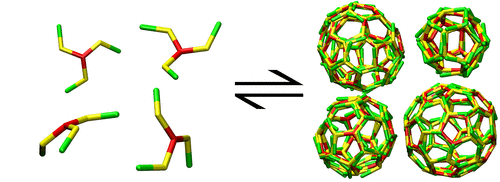Clathrins are three legged proteins
with the remarkable ability to self-assemble
into polyhedral cages of various sizes.
They play an important role in
endocytosis,
the process used by living cells
to internalize a wide range of cargo molecules.
By growing a lattice against the
inner side of the cell membrane,
they curve the membrane around
the cargo attached to the
outer side of the membrane,
thereby creating
within the cell
a clathrin coated vesicle containing the cargo.
After shedding the coat,
the vesicle transports its cargo to a destination in the cell
for further processing.

We have developed a highly coarse grained model
to simulate the self-assembly process
of clathrins into polyhedral cages.
Simulations with this
patchy particle model offer new possibilities,
supplementary to and in collaboration with experiments,
to advance the understanding
of the essential steps in cage formation and endocytosis.
An important conclusion from the first simulations is
that clathrin's characteristic shape does not suffice
for the self-assembly;
in stead, the interaction sites must be
asymmetrically distributed
over the legs's circumferences
[
1,
2].
Click here to watch a
movie (20MB)
of two clathrin cages self-assembling from solution.
The simulations also solve the conundrum
of how a flat hexagonal clathrin lattice
can generate a clathrin cage with 12 pentagonal faces.
[
3].

